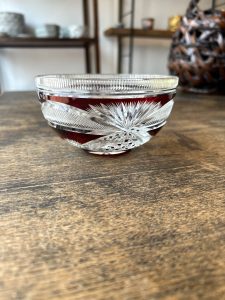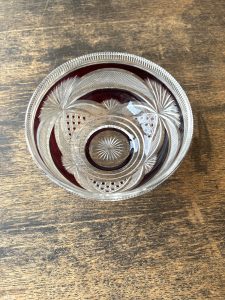切子の抹茶碗、涼しげです(愛知県名古屋市千種区姫池通 骨董買取 古美術風光舎)
2025.05.14
昨夜の満月はオレンジ色に輝き美しかったですね。5月の満月は花の季節の満月ということで「フラワームーン」と呼ばれ、さそり座との共演が天体ファンには話題となっているようです。
本日も少し欠けた十六夜の月が、さそり座の心臓の位置で瞬くアンタレスの近くで輝き、月とのコントラストが楽しめるということです。せっかくですので今夜、夜空を見上げてみてはいかがでしょうか。
さて本日仲間入りしました、切子の抹茶碗。繊細なカットと深い赤色が美しく見飽きることがありません。両手で包むとひんやりとした感触が心地よく手に馴染みます。光の当たり具合で表情が変わるのも魅力です。

切子はガラスの装飾加工法の名称でもあり製品の名前でもあります。切子の「子」とはガラスを削る際に出るガラスの「粉」を「子」に変換したものとされています。切子のもとの意味は、立方体の角を切り落とした形を意味する「切籠形(きりこがた)」に由来すると言われています。
金属製の回転砥石を使ってガラスに溝を入れたり、研磨したりすることで個性豊かなデザインが生み出されています。よく映像を目にしますが、魔法のように模様が刻み込まれていく様子は神業としか思えません。高い職人技術と集中力が必要とされるのは言うまでもありません。
日本で生まれた二大カットガラスとして江戸切子と薩摩切子が挙げられますがどのような違いがあるのでしょうか。
江戸切子は文字通り江戸時代後期から現在に至るまで江戸、東京で生産されている切子加工を施されガラス製品の総称です。江戸時代後期に江戸のガラス問屋の加賀屋久兵衛が海外のガラス製品に切子の細工を施したのが始まりとされています。1830年代に研磨剤を用いた技術が発展したことから、多くのガラス職人により食器、風鈴、重箱などが様々な日用品が手掛けられるようになり、庶民に愛されたガラス製品です。
薄いガラスに色ガラスを被せ、シャープにカットされており、透明な部分と色との境界がはっきりしているのが特徴だそうです。
現在江戸切子で一番で値段が高い色が「黒色」とされ、ガラスの色が濃いほどカットする線が見えにくくなるため熟練の職人にしか扱えないのだとか。
1985年に東京都の伝統工芸品産業に指定され、2002年には国の伝統工芸品にも指定され、現在も多くの人に愛用されています。
薩摩切子の文化は27代藩主の島津斉彬が藩主の時代(1851年~1858年)に花開きました。斉彬は切子を発展させることで藩の産業にまで押し上げたとされています。色ガラスの研究に力を注ぎ、中でも薩摩の赤は「紅ガラス」と呼ばれたそうです。
しかし斉彬の死後、薩摩切子は急速に衰退し、たった7年という斉彬の藩主時代の薩摩切子は幻の切子と呼ばれるようになりました。1985年に残された資料を元に復元事業が始まり、1986年に製造販売が開始されています。
厚いガラスに色ガラスを被せており、ほかしを表現するようにカットされ、透明な部分と色との境界が曖昧でグラデーションが美しいのが特徴です。
ガラスの抹茶碗というのはあまり馴染みが無かったのですが、これからの季節、お茶の席を爽やかに演出してくれそうです。このガラスの茶碗に抹茶の色が加わると一体どのようなコントラストが生まれるのでしょうか。興味津々です。

それでは、また次の機会に。(スタッフH)
Yesterday’s full moon was beautiful with its orange glow; the full moon in May is called the “flower moon” because it is the full moon of the flower season, and its co-starring with Scorpius is a hot topic among celestial fans.
Today, the slightly chipped moon of the 16th night will shine near Antares, which is twinkling at the heart of Scorpius, and we can enjoy the contrast with the moon. Since we are here, why not look up at the night sky tonight?
Now, a faceted matcha bowl has joined our collection today. The delicate cut and deep red color are beautiful and never get tired of looking at them. When you wrap your hands around it, the cool feeling is pleasant and comfortable to the touch. It is also attractive that the expression changes depending on how the light hits it.
Faceted glass is both the name of the glass decoration process and the name of the product. The word “kiriko” in faceted glass is said to have been converted from “ko” to “ko” from the glass “powder” that is produced when cutting glass. The original meaning of the word “facet” is said to derive from “kiriko-gata,” which means the shape of a cube with its corners cut off.
The unique designs are created by grooving and polishing the glass using a metal rotating wheel. We often see images of this process, and the way the patterns are magically etched into the glass is nothing short of divine. Needless to say, it requires a high level of craftsmanship and concentration.
Edo faceting and Satsuma faceting are the two major types of cut glass produced in Japan, but what are the differences between them?
Edo faceting is literally a generic term for faceted glass products produced in Edo (Tokyo) from the late Edo period to the present. It is said that the Edo faceting started in the late Edo period when Kyubei Kagaya, a glass wholesaler in Edo, started faceting foreign glass products. These glass products were loved by the general public.
It is characterized by thin glass covered with colored glass, sharply cut, and the boundary between the transparent part and the color is clear.
The darker the color of the glass, the harder it is to see the cut lines, so only skilled craftsmen can handle it.
In 1985, it was designated as a traditional craft industry by the Tokyo Metropolitan Government, and in 2002, it was also designated as a national traditional craft.
The culture of Satsuma faceting blossomed during the reign of Shimazu Nariakira, the 27th lord of the domain (1851-1858). Nariakira is credited with developing faceting and pushing it to the point where it became an industry of the domain. He devoted himself to the research of colored glass, and among them, the red of Satsuma was called “Beni Glass”.
After Nariakira’s death, however, Satsuma faceting rapidly declined, and the Satsuma faceting produced during Nariakira’s time as feudal lord, which lasted only seven years, came to be known as “phantom faceting.
It is made of thick glass covered with colored glass, cut in a way that it expresses faintness, and features a beautiful gradation with a vague boundary between the transparent part and the colored part.
I have not been familiar with glass matcha bowls, but I think they will make a refreshing addition to the tea ceremony in the coming season. What kind of contrast will be created when the color of matcha is added to this glass tea bowl? I am very curious.
See you next time (Staff H)
If you have time, please come visit us at Fukousha Antique Gallery.
*****************
ご実家の整理やお片付けなどをされている方のご相談などが多くございます。
お片付けなどくれぐれもご無理のないようになさってくださいませ。
風光舎では古美術品や骨董品の他にも絵画や宝石、趣味のお品など様々なジャンルのものを買受しております。
お片付けをされていて、こういうものでもいいのかしらと迷われているものでも、どうぞお気軽にご相談下さいませ。
また風光舎は、出張買取も強化しております。ご近所はもちろん、愛知県内、岐阜県、三重県その他の県へも出張いたします。
まずは、お電話お待ちしております。
なお、毎月21日の持込鑑定会では無料鑑定・買取・持込など、ご予約なしで承っております。
ご近所の皆さま、ご遠方のみなさまも、お気軽にお越しくださいませ。
愛知県名古屋市千種区姫池通
骨董 買取【古美術 風光舎 名古屋店】
TEL052(734)8444
10:00-18:00 OPEN
#出張買取#骨董#古美術#骨董品#絵画#版画#茶道具#刀剣#彫刻

